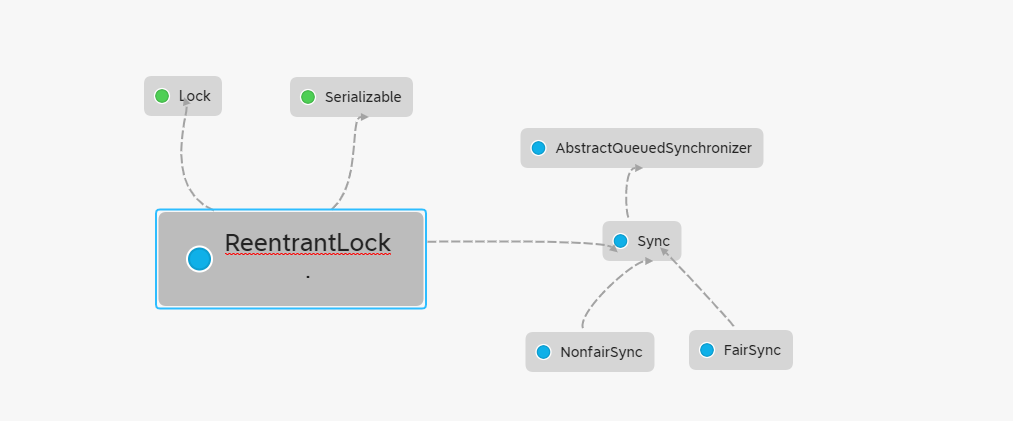1 示例
public class ReentrantLockTest {public static void main(String[] args) {ThreadDemo demo = new ThreadDemo();ThreadDemo2 lockDemo = new ThreadDemo2();Thread t = new Thread(demo);Thread t2 = new Thread(demo);Thread tt = new Thread(lockDemo);Thread tt2 = new Thread(lockDemo);t.start();t2.start();tt.start();tt2.start();}}class ThreadDemo implements Runnable {volatile int num = 0;ReentrantLock lock = new ReentrantLock();@Overridepublic void run() {lock.lock();for (int i = 0; i < 1000000; i++) {num++;}System.out.println("加锁操作后,num:" + num);lock.unlock();}}class ThreadDemo2 implements Runnable {int num = 0;@Overridepublic void run() {for (int i = 0; i < 1000000; i++) {num++;}System.out.println("不加锁,num:" + num);}}
输出:
不加锁,num:1123472加锁操作后,num:1000000不加锁,num:1979071加锁操作后,num:2000000
2 类结构关系
ReentrantLock 是可重入的独占锁 只能有 线程可 获取该锁,其 获取该锁的线程会被阻塞而被放入该锁的 阻塞队列里面。
ReentrantLock 最终还是使用 AQS 来实 的,并且根据参数来决定其内部是一个公平还是非公平锁,默认是非公平锁。
//无参构造,默认是非公平锁public ReentrantLock() {sync = new NonfairSync();}//根据参数来决定其内部是一个公平还是非公平锁public ReentrantLock(boolean fair) {sync = fair ? new FairSync() : new NonfairSync();}
其中 Sync 类直接继承自 AQS 它的子类 No fairSy FairSync 分别实现了获取锁的非公平与公平策略 。
在这里, AQS state 态值表示线程获取该锁的可重入次数 在默认情况下, state的值为 表示当前锁没有被任何线程持有 线程第 次获取该锁 会尝试使用 CAS 设置 state 的值为 ,如果 CAS 成功则当前线程获取了该锁,然后记录该锁的持有者为当前线程 在该线程没有释放锁的情况下第 次获取该锁后 ,状态值被设置为 这就是可重入次数 在该线程释放该锁时,会尝试使用 CAS 让状态值减 如果减 后状态值为 0,则当前线程释放该锁。
3 NonfairSync实现原理
3.1 lock
public void lock() {sync.lock();}
final void lock() {if (compareAndSetState(0, 1))//CAS成功,设置该锁持有者是当前线程setExclusiveOwnerThread(Thread.currentThread());else//CAS失败,尝试获取锁acquire(1);}
3.2 acquire
public final void acquire(int arg) {if (!tryAcquire(arg) &&//获取锁失败,会把当前线程放入AQS 阻塞队列acquireQueued(addWaiter(Node.EXCLUSIVE), arg))selfInterrupt();}
3.3 tryAcquire
protected final boolean tryAcquire(int acquires) {return nonfairTryAcquire(acquires);}
final boolean nonfairTryAcquire(int acquires) {final Thread current = Thread.currentThread();int c = getState();if (c == 0) { //当前AQS state状态值是0(无锁);if (compareAndSetState(0, acquires)) {setExclusiveOwnerThread(current); //CAS成功,设置该锁持有者是当前线程return true;}}else if (current == getExclusiveOwnerThread()) { //当前线程是该锁持有者int nextc = c + acquires; //状态值加1if (nextc < 0) // overflowthrow new Error("Maximum lock count exceeded");setState(nextc);return true;}return false; //都不是,返回false,丢入队列}
3.4 unlock
public void unlock() {sync.release(1);}
public final boolean release(int arg) {if (tryRelease(arg)) {Node h = head;if (h != null && h.waitStatus != 0)unparkSuccessor(h);return true;}return false;}
3.5 tryRelease
此方法为抽象类Sync的final方法,公平锁和非公平锁公用此方法
protected final boolean tryRelease(int releases) {int c = getState() - releases; //重入次数减1//如果当前线程不是锁持有者,抛异常if (Thread.currentThread() != getExclusiveOwnerThread())throw new IllegalMonitorStateException();boolean free = false;if (c == 0) { //如果当前可重入次数为0,清空锁free = true;setExclusiveOwnerThread(null);}setState(c); //重入次数减1return free;}
4 FairSync 实现原理
公平锁的话只需要看 FairSync 重写 tryAcquire方法。
4.1 tryAcquire
protected final boolean tryAcquire(int acquires) {final Thread current = Thread.currentThread();int c = getState();if (c == 0) { //当前AQS state状态值是0(无锁);// 只有队列为空时,才会通过CAS尝试获取锁if (!hasQueuedPredecessors() &&compareAndSetState(0, acquires)) {setExclusiveOwnerThread(current);return true;}}else if (current == getExclusiveOwnerThread()) { //当前线程是该锁持有者int nextc = c + acquires;if (nextc < 0)throw new Error("Maximum lock count exceeded");setState(nextc);return true;}return false;}}
4.2 hasQueuedPredecessors
public final boolean hasQueuedPredecessors() {// The correctness of this depends on head being initialized// before tail and on head.next being accurate if the current// thread is first in queue.Node t = tail; // Read fields in reverse initialization orderNode h = head;Node s;//如果 h==t 说明当前队列为空,直接返回 falsereturn h != t &&((s = h.next) == null || s.thread != Thread.currentThread());}
在如上代码中,如果当前线程节点有前驱节点则返回住时, 如果当前 AQ 队列为空或者当前线程节点是 AQS 第一个节点则返回 false 。其中如果 h==t 说明当前队列为空,直接返回 false ;如果 h!=t 并且 ==null 则说明有一个元素将要作为 QS 第一个节点入队列 (回顾前面的内容, enq 数的第一个元素入队列是两步操作: 首先 建一个哨兵头节点,然后将第一 元素插入哨兵节点后 ,那么返回 true ,如果 h!=t 并且 s!=null和s.thr巳ad != Thread.cunentThread()则说明队列 面的第 个元 不是当前线程,那么返回true

